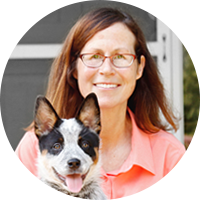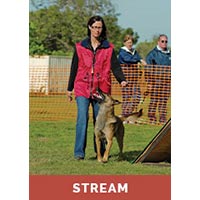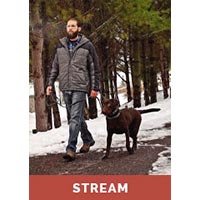November 04, 2021
My 8 month old GSD is heeling well on and off leash and I have been using the remote collar for more than a month. When she noses the ground while heeling I give a low level E-collar stimulation and then when we walk back over that area she will side step and avoid the spot where she was corrected. Should I be correcting her with the E-collar?
Full Question:
Hello Cindy,My question is concerning an 8 mons old working line GSD.
She heels very well both on and off-leash. I have been using an E-collar with her for more than a month now.
So far all E-collar training has been relatively Distraction free.
One quirk that puzzles me is a few times now when she noses the ground during a heel command I will give her a low-level stim to correct her. When we walk back over this same area again which is usually grassy she will side step the spot she received the correction, usually moving behind me or even attempt to move between my legs. Once past the spot she will move back into heel position.
Should I be correcting her E-collar wise at this point? I have given her an E-collar correction but not sure how to proceed fairly.
Thank you

 Cindy's Answer:
Cindy's Answer:
What you have done is accidentally created a superstitious association to a specific area with the E-collar. Your dog didn't associate your correction with her behavior, she associated it with the location in which the correction occurred so that's why she's avoiding it.
Using an E-collar for heeling and things like being distracted with such a young dog is likely confusing her. I prefer to use motivation to keep the dog's attention during the learning phase. She's very young and heeling with distractions is a lot to ask from such a young dog. I wouldn't use the E-collar for complex behaviors with an 8-month-old dog. I'm usually just starting to let the dog wear the collar and conditioning them to it at that age (or older).
What are the training goals for her? Is she a companion dog only or will she be a working dog of some sort (competitions or dog sports)?
Using an E-collar for heeling and things like being distracted with such a young dog is likely confusing her. I prefer to use motivation to keep the dog's attention during the learning phase. She's very young and heeling with distractions is a lot to ask from such a young dog. I wouldn't use the E-collar for complex behaviors with an 8-month-old dog. I'm usually just starting to let the dog wear the collar and conditioning them to it at that age (or older).
What are the training goals for her? Is she a companion dog only or will she be a working dog of some sort (competitions or dog sports)?
User Response:
She is a companion with hopes of hiking, running, etc. when she is old enough.We live very rural but I take her into town 3 days a week. We train/walk near a busy trail, keep r distance for now, from people, dogs.
I have zero expectations of her heeling in this environment.
But apparently, I do expect too much from her too soon as u say.
She’s actually very level-headed and receptive to training. I just don’t want to confuse her out of my lack of training knowledge. I guess that’s where u guys come in. Lol.

 Cindy's Answer:
Cindy's Answer:
I think heeling is one of the most complex behaviors to teach dogs, there are a lot of things they need to understand and using the E-collar for a young dog/pup for an "abstract" behavior like heeling can cause a lot of confusion.
If she's doing well with the collar in other areas of training maybe just hold off on using it for heeling right now and think about it from the dog's point of view. I want to use any correction for a dog not doing a command the dog is super clear on. Heeling is complex, the dog needs to walk, stay in a specific area next to you and if you are using the collar because she puts her nose on the ground does she understand what she's supposed to do instead?
I break heeling down into many small parts. The first thing the dog learns is to stay next to me in a stationary position and they have to look at me. I use a verbal cue for the position and a cue for the focus. So if my dog looks away I can so NO, Look. If your heeling command covers many different expectations then you can see how the dog may be confused.
My dog knows how to get into position, how to focus on me, how to stay next to me, how to move forward and backward on cue, and how to get closer to me if he would get too far away. Then he has to be able to do all of this while moving. My 9-month-old dog is just learning how to sit next to me and focus with only rewards for correct choices and nothing for a wrong one. He'll get the E-collar layered in much later when everything is 100% understood and fluent. I teach all my companion dogs the same skills as my competition dogs but without so much emphasis on precision.
If you don't want to teach focused heeling then the same type of rules apply without expecting the dog to watch you. We call this loose leash walking. I hope this makes sense.
If she's doing well with the collar in other areas of training maybe just hold off on using it for heeling right now and think about it from the dog's point of view. I want to use any correction for a dog not doing a command the dog is super clear on. Heeling is complex, the dog needs to walk, stay in a specific area next to you and if you are using the collar because she puts her nose on the ground does she understand what she's supposed to do instead?
I break heeling down into many small parts. The first thing the dog learns is to stay next to me in a stationary position and they have to look at me. I use a verbal cue for the position and a cue for the focus. So if my dog looks away I can so NO, Look. If your heeling command covers many different expectations then you can see how the dog may be confused.
My dog knows how to get into position, how to focus on me, how to stay next to me, how to move forward and backward on cue, and how to get closer to me if he would get too far away. Then he has to be able to do all of this while moving. My 9-month-old dog is just learning how to sit next to me and focus with only rewards for correct choices and nothing for a wrong one. He'll get the E-collar layered in much later when everything is 100% understood and fluent. I teach all my companion dogs the same skills as my competition dogs but without so much emphasis on precision.
If you don't want to teach focused heeling then the same type of rules apply without expecting the dog to watch you. We call this loose leash walking. I hope this makes sense.
User Response:
Yes! Makes perfect sense!Thanks for your time and advice. I certainly value it greatly!:)
100% (4 out of 4)
respondents found this answer helpful


Can't find what you're looking for?








